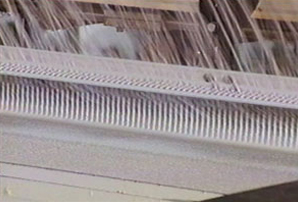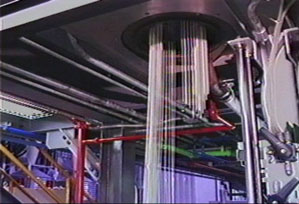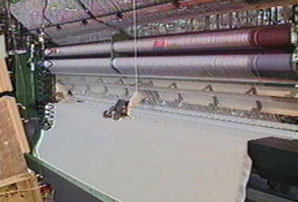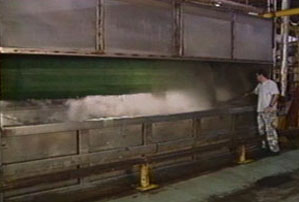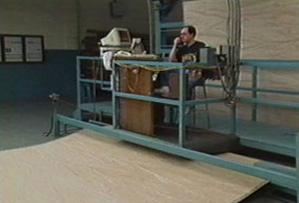Carpet | How It's Made
Knowing how carpet is made can be very advantageous. Knowing the different materials that make up various carpets also helps you understand and evaluate their performance aspects: why certain carpets are easier to install, why some wear better, longer, and why others are easier to care for and clean. It can also make you a smarter shopper.
Selections:
- thicker is not always better
- tight twist in each yarn is better than loose and frayed
- firm and dense pile means quality
- the more backing seen, the less dense and durable
- high traffic areas need lower profiles to avoid matting and crushing
Step 1: Fiber
- basic material of makeup
- 90% is synthetic fiber
- rest is natural fiber, mostly wool
Synthetic Fibers
- made up of 1 of 3 materials: nylon, polypropylene or polyester
- created by chemical processes from oil and natural gas
Nylon
- 75% is made of nylon
- performs the best overall
- leader in: appearance retention, fade and heat resistance, soil and stain resistance, color and styling
- highest performance nylon is Type 6.6 for more resistant to stain penetration
Polypropylene
- next most common material is polypropylene
- introduced in the late 1950's in Italy
- BCF represents more than 35% of all fibers
- not as resilient or resistant to abrasion as nylon
- naturally stain and fade resistant
- naturally resistance to moisture
- more limited range of color options
- most often used in loop pile constructions
Polyester
- third type of material is polyester
- introduced to the carpet industry in the mid 1960's
- well accepted for bulkiness, color clarity, and good stain and fade resistance
- not as resilient as nylon
- can be a good performer
PET
- Mohawk makes from plastic bottles
- plastic is collected, separated by color, and then ground and melted
- used to manufacture the PET carpet fiber
- carpets made by Mohawk of PET staple fiber made from 100% recycled material
- great color clarity, stain resistance, durability
- keeps over 3 billion bottles out of landfills
SmartStrand
- made with DuPont Sonora polymer
- DuPont and Mohawk make this fiber into carpet
- SmartStrand with DuPont Sorona is continuous filament fiber
- eliminates shedding
- highly stain resistant and durable
- 40% of the fiber made from corn by products
Wool
- The above three materials make up the majority of synthetic fibers.
- The other type of fiber used in carpet construction is staple fiber.
- While some synthetics are used in the creation of staple fibers, the original staple fiber used in the making of carpet is wool.
- The wool used in today's carpet comes primarily from New Zealand, Argentina, and the United Kingdom.
- Since wool is a natural fiber, it ranges in color from off-white to black, with many earthen tones between.
- Wool doesn't stand up to abrasion and moisture as well as synthetics, it cleans well and is known to age gracefully.
- Wool is the most expensive carpet fiber, and represents less than one percent of the U.S. carpet market.
Berber
- considered a type of carpet construction
- actually comes from the name of a group of North African sheepherders called the Berbers
- Berbers produced coarse wool, with color flecks in their yarns
Carpet is made in a 3-part process.
#1 Tufting
- begins with weaving the synthetic or staple fiber into a primary backing material
- usually made of woven polypropylene
- main value is to provide a base cloth to hold the yarn while tufting happens
- tufting machine has 800 to 2000 needles like a sewing machine to pull the yarn through the primary backing material
- tufting machine is 12 feet wide, its needles penetrate the backing and a small hook (looper) grabs the yarn and holds it in place
Loop pile construction
- holds appearance well
- no exposed yarn tips
- only sides of the yarn are exposed to wear and stress
- known to hold up the best
Alternative step
- sometimes the looper cuts small loops creating a cut pile
- length of these pieces called pile height, or distance between the looper and primary backing
- cuts are controlled by a computer, and can be programmed to cut only some of the loops
- this cutting is called cut and loop construction and creates pattern on the surface
#2 Application of dye
Two dyeing processes
- yarn dyeing / pre-dyeing - color is applied to the yarn prior to tufting
- advantages are good side-by-side color consistency, large lot sizes, uniformity
- carpet dyeing - applying color to the yarn after tufting
- benefits - greater color flexibility
Carpet dyeing methods
- Beck / batch dyeing - stitching the ends together, then running the tufted carpet loop through large vats of dye and water for several hours.
- Beck process ideal for small runs, heavier face weight products
- continuous dyeing - similar to Beck dyeing - carpet is also run through processes other than dyeing
- continuous dyeing - applies color to the face by spraying or printing, also to create multicolor or patterned effects
- screen printing - color is applied through anywhere from 1-8 silk-screens.
#3 Manufacturing the carpet
- finishing process- single production line that completes
the final construction stages
- coating of latex applied to dyed carpet's primary and secondary backing
-
- secondary backing - made of woven synthetic polypropylene
- two parts are squeezed together in a large heated press and held firmly to preserve shape
- shearing- removing loose ends and projecting fibers created during the tufting process
- also helps the yarn's tip definition
- inspection - for color uniformity and defects before it is rolled, wrapped, and shipped
Terms and construction variables
Pile height, or nap
- length of the tuft measured from the primary backing to the yarn tips
- shown as a fraction, or decimal equivalent
- shorter pile is more durable than longer pile
- stitch rate - measure of how close the yarns are together
- stitch rate is measured in penetrations, or tufts, in a given length of carpet, usually an inch.
- stitch rate is controlled by the speed the carpet is moved through the tufting machine
- good number is seven to eight tufts per inch
- face weight-actual amount of fiber per square yard, measured in ounces
- typical carpet may have a face weight of 35 to 45 oz
- density- how tightly the yarn is stitched into the primary backing
- higher density will wear better than low density


